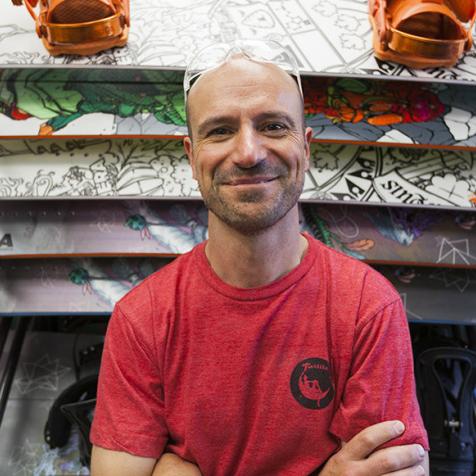
Company Details
Location
Salt Lake City, Utah
Founded
2010
Ownership Type
Private
Employees
5
Products
Snowboards
Salt Lake City
Founded: 2010
Privately owned
Employees: 5
Industry: Lifestyle & Consumer
Product: Splitboards
Owner Alister Horn's splitboards cater to customers conquering new mountains.
Since chairlifts were installed at Idaho's Sun Valley Resort in 1936, most skiers and snowboarders have taken the easy way up. Horn isn't one of them.
Before dedicating his time to growing Chimera, Horn, who has a background in engineering, was living in a Colorado ski town and working in New Mexico. "I came to Utah for the snowboarding," Horn says, "and one thing just led to another."

Chimera manufactures splitboards, a growing niche in the snowboarding market. "Splitboarding was something that was started here over 20 years ago," Horn explains. "The board is cutdown the middle -- dead straight -- and having two parts as skis allows you to skin up the hill. At the top, you bind the two pieces together with specialized hardware to make a full snowboard, and you snowboard down."
Horn sells his splitboards to dedicated enthusiasts who have left the resort scene for adventures in the backcountry. "Our users are all in the backcountry," Horn says. "Until recently, snowboarding was resort-driven but now they are all going to splitboarding. You ski up and ride incredible terrain back down, all day long. Once snowboarders 'get' splitboarding, they rarely go back. They’re devoted. That's what has allowed us to survive and what is putting us in a position for even bigger growth."
Before Chimera, choices for factory splitboard equipment were relatively limited, and many splitboarders resorted to create their own equipment. To do so, they simply ran a snowboard through a table saw and applied the hardware on their own. In fact, that's how Horn created his own splitboard.

Until he realized there had to be a better way. "I bought a lot of books, and I got on the Internet," he says. Now, Chimera produces high-end splitboards.
Today, Horn starts with a wood core then adds specialty materials, such high-density plastic, fiberglass, and carbon fiber. His designs are then printed on topsheets.
"Everything needs to be carefully treated," Horn says. "Plastic and metals are hard to bond to, hard to glue and not have it fall apart out of the press. Everything has to be treated and built from the bottom up. Our boards are basically big sandwiches that are pressed and heated until the glue is solid. After that, it's still a lot of work before you have a really good finish."
Of the various innovations found in Chimera boards, the edge is the most noticeable. Chimera splitboards use plastic, not steel, on the inside edges because, he says, "It provides a much more desirable flex. Snowboards perform much better with a 'damp' flex-pattern -- no vibration. We deliver that."
Horn also chooses to create white boards. "That's a very different approach from other snowboards, which are often black, or dark," he says. "Each our design features produces a noticeable difference. For example, if you snowboard with a black board, the top will get warm and snow will actually stick to it. You can be stuck carrying around pounds of snow. Our boards are white, which dramatically decreases the absorption of light and heat, which in turn prevents melt freeze and reduces ice buildup. It's one of those things that snowboarders don’t usually notice, but a splitboarder, who is carrying the snow on his skis, is acutely aware of. It's something that we use to differentiate ourselves."

Today, Chimera's boards are still crafted by Horn, with part-time support at critical periods of the year. "I never intended to start a real business," he admits. "It was just a hobby. But my friends saw my boards, word spread, and soon I was swamped with orders for them."
Because the boards are handmade, Horn's costs are high. "It's definitely a premium, high-end product," he says. For that reason, Horn ships directly to consumers. "We provide a must-have product people cannot find anywhere else. We're positioned to clients who really appreciate their splitboard and want to support splitboarding. That's the model we are using."
Challenges: Growth. Horn realizes he needs a stronger retail presence but that requires getting costs to a manageable price point. "Making the transition is difficult," Horn admits. "It requires a big risk because to get costs down, you have to ramp up manufacturing. And that requires me to hire people and write some big checks, which I won't see back for months. It's a difficult transition, but I think the time is right."
Opportunities: Driving growth with marketing. Horn has paired up with a well-known marketing expert who previously worked in the biking industry. "He has helped me for years," he says, "and when we started to make plans to grow, he was a natural partner." Through his expertise, Horn hopes to extend all branding and marketing efforts. "We're growing. We're in transition. That's our focus right now. People who ride our splitboards love them, we just need to get that message out."
Needs: Cash flow. "Going to a bank with a business which looks like a hobby and convince them to write a check, well, it can be a challenge," says Horn.

